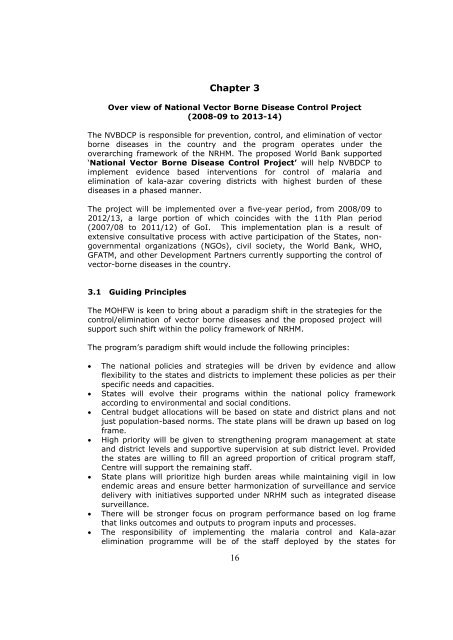National Project Implementation Plan - NVBDCP
National Project Implementation Plan - NVBDCP
National Project Implementation Plan - NVBDCP
You also want an ePaper? Increase the reach of your titles
YUMPU automatically turns print PDFs into web optimized ePapers that Google loves.
Chapter 3<br />
Over view of <strong>National</strong> Vector Borne Disease Control <strong>Project</strong><br />
(2008-09 to 2013-14)<br />
The <strong>NVBDCP</strong> is responsible for prevention, control, and elimination of vector<br />
borne diseases in the country and the program operates under the<br />
overarching framework of the NRHM. The proposed World Bank supported<br />
‘<strong>National</strong> Vector Borne Disease Control <strong>Project</strong>’ will help <strong>NVBDCP</strong> to<br />
implement evidence based interventions for control of malaria and<br />
elimination of kala-azar covering districts with highest burden of these<br />
diseases in a phased manner.<br />
The project will be implemented over a five-year period, from 2008/09 to<br />
2012/13, a large portion of which coincides with the 11th <strong>Plan</strong> period<br />
(2007/08 to 2011/12) of GoI. This implementation plan is a result of<br />
extensive consultative process with active participation of the States, nongovernmental<br />
organizations (NGOs), civil society, the World Bank, WHO,<br />
GFATM, and other Development Partners currently supporting the control of<br />
vector-borne diseases in the country.<br />
3.1 Guiding Principles<br />
The MOHFW is keen to bring about a paradigm shift in the strategies for the<br />
control/elimination of vector borne diseases and the proposed project will<br />
support such shift within the policy framework of NRHM.<br />
The program’s paradigm shift would include the following principles:<br />
<br />
<br />
<br />
<br />
<br />
<br />
<br />
The national policies and strategies will be driven by evidence and allow<br />
flexibility to the states and districts to implement these policies as per their<br />
specific needs and capacities.<br />
States will evolve their programs within the national policy framework<br />
according to environmental and social conditions.<br />
Central budget allocations will be based on state and district plans and not<br />
just population-based norms. The state plans will be drawn up based on log<br />
frame.<br />
High priority will be given to strengthening program management at state<br />
and district levels and supportive supervision at sub district level. Provided<br />
the states are willing to fill an agreed proportion of critical program staff,<br />
Centre will support the remaining staff.<br />
State plans will prioritize high burden areas while maintaining vigil in low<br />
endemic areas and ensure better harmonization of surveillance and service<br />
delivery with initiatives supported under NRHM such as integrated disease<br />
surveillance.<br />
There will be stronger focus on program performance based on log frame<br />
that links outcomes and outputs to program inputs and processes.<br />
The responsibility of implementing the malaria control and Kala-azar<br />
elimination programme will be of the staff deployed by the states for<br />
16

















